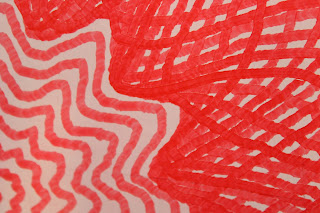I need to get back to playing with this. Maybe after my new workshop is done.
white board doodler
Monday, December 22, 2025
Thursday, March 4, 2021
math behind the guilloche
These are the parts of the program that draw each section in case someone wants to know the math.
This is the first set of spirals.
for (float theta = 0.0; theta < 16.0 * PI + 0.02; theta = theta + 0.02){
float radius = 120.0 * theta / (16.0 * PI);
radius = radius + sin(theta * 12.0) * theta * 15.0 / (16.0 * PI);
float xp = sin(theta) * radius;
float yp = cos(theta) * radius;
draw(xp,yp);
}
Sunday, February 28, 2021
Guilloche time lapse
I videoed this as a series of one minute videos. It actually took about two hours to plot. It was inspired by this guy.
https://youtu.be/qjc-oAkoKvY
I am a fan of the axidraw plotter and look what people are doing with it.
I have slow internet so I was going to upload a bunch of short videos and got tired of doing them all.
I found some shareware that would help me link them all together and speed it up. So it is not a normal timelapse made from a bunch of photos.
After I drew it I zoomed in and took some photos up close. There are some interesting textures.
Thursday, February 18, 2021
Cardioid
Today I was inspired by this guys pictures.
http://inkylines.blogspot.com/2019/05/full-gallery-httpswww.html
Here is what I did with it.
Saturday, January 2, 2021
Waves Flower1 Flower2 and Slinky
I did some more pictures from Matthias Wandel.
This is his website where I got the ideas.
http://matt.wandel.ca/artwork/math_art.html
First I did Waves again but bigger than before.
Then I did the one called Flower1.
Then I did Flower2.
Then I did Slinky.
Shingles and Waves
The idea for these pictures came from this website.
http://matt.wandel.ca/artwork/math_art.html
This is an old website by Matthias Wandel of woodgears.ca fame.
The first picture is one he called "shingles."

Friday, December 25, 2020
Saturday, July 6, 2019
Butterfly
https://sisyphus-industries.com/
The first time I did it I started it going, watched the first part and then went off to work in the yard.
It drew a little bit too big.
So I shrunk it by 10%.
I made videos of both of them. Since this is just drawing the path and not stopping to draw circles it only takes about an hour to draw either one so it appears to move much faster than in previous videos. It is actually sped up by the same amount as the longer videos on previous days.
I also see that I need to cover the window next to the doodler when I film these during the day time.





















